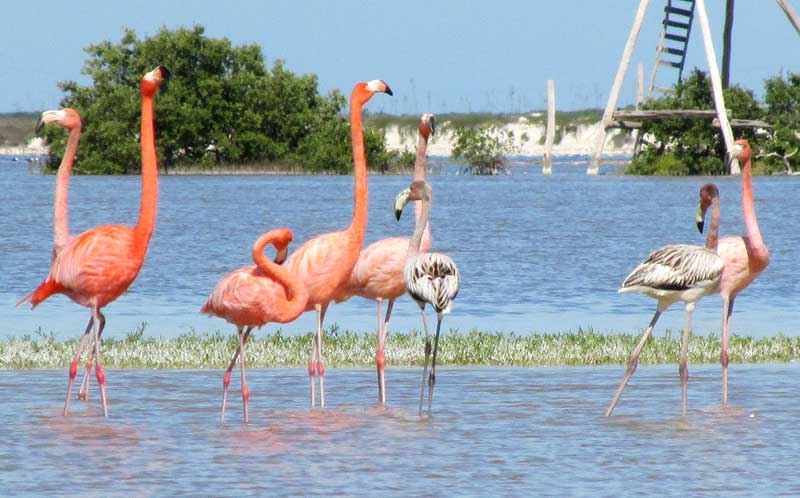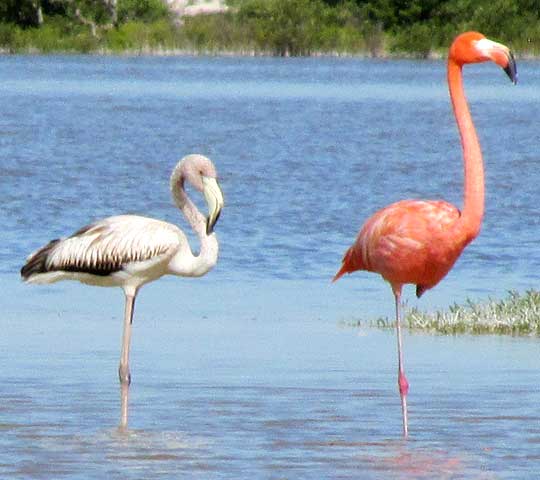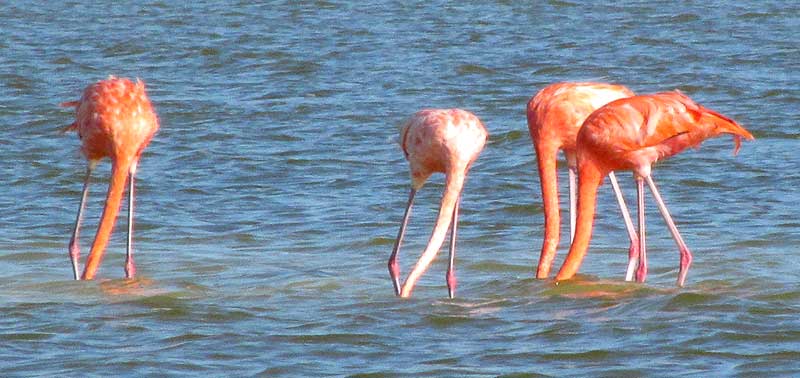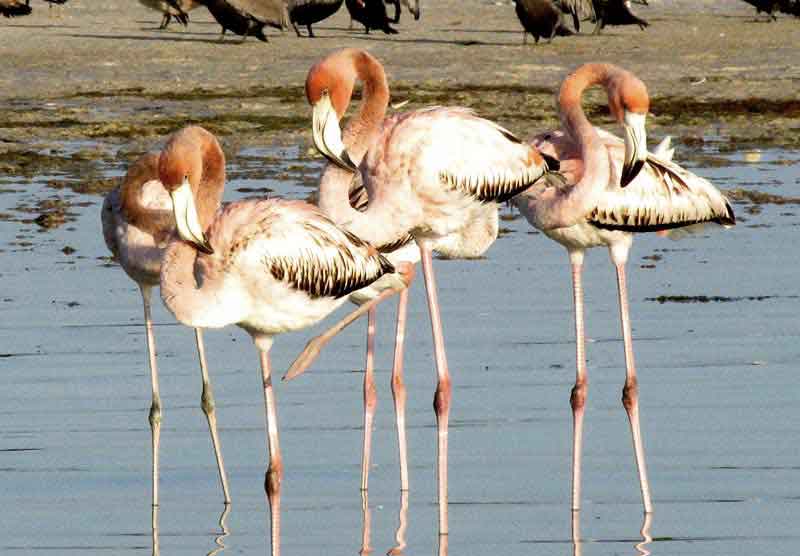Excerpts from Jim Conrad's
Naturalist Newsletter

from the November 16, 2014 Newsletter issued from Río Lagartos, on the Yucatan Peninsula's northern coast (~N21.60°, ~W88.16°), Yucatán state, MÉXICO
AMERICAN FLAMINGOS, PINK AND WHITE
Above you see a typical view of American Flamingos, PHOENICOPTERUS RUBER, lounging in Ría Lagartos estuary. Notice that the larger adults are pink but smaller immature birds can be white. Another picture of a pink adult with a white kid is shown below:

Young Flamingos first grow white feathers, and then the feathers eventually turn pink as the birds eat brine shrimp and other tiny crustaceans as well as algae containing pigments called carotenoids. Enzymes in the Flamingo's liver break down the carotenoids into pink and orange pigment molecules, which then are distributed to the bird's feathers, bill, and legs. The more carotenoids a Flamingo eats, the pinker it gets.
from the November 30, 2014 Newsletter issued from Río Lagartos, on the Yucatan Peninsula's northern coast (~N21.60°, ~W88.16°), Yucatán state, MÉXICO
FLAMINGOS FEEDING
Flamingos don't peck at their food or capture small prey to gobble down like most birds, but are "filter feeders." In that respect they're more like whales and oysters than the vast majority of other birds. When they feed in their preferred environments, typically they have their heads upside-down, under the water, as seen below:

In this position they take in water in which tiny brine shrimp and blue-green algae are suspended. These animals are filtered out with the help of many complex rows of horny plates lining the beak inside. That's the same food-straining process used by baleen whales. In order for the beak to work "normally" on a head being held upside-down, the flamingo's upper jaw is not rigidly fixed to the skull the way it is in most other animals. This means that as the bird feeds, the upper bill -- which is the lower bill on an upside-down head -- moves up and down just like a human's lower jaw.
The filtering process is helped by the flamingo swinging its head back and forth and letting the water flow through the bill. As this happens, the tongue pumps water through the bill's strainer by quickly moving back and forth in its groove, sucking water in when it pulls back, and expelling water when it pushes forward. This motion is repeated up to four times a second.
from the January 18, 2015 Newsletter issued from Río Lagartos, on the Yucatan Peninsula's northern coast (~N21.60°, ~W88.16°), Yucatán state, MÉXICO
YOUNG FLAMINGOS PREENING
On Thursday morning the tide was low, the sun warm and the wind hardly stirring. It was a good time for adolescent flamingos to huddle close together the way self-conscious teenagers often do, and preen. Below, you can see this prettily done.

from the December 12, 2004 Newsletter issued from near Telchac Pueblo on the Yucatan Peninsula's northern coast (~N21.60°, ~W88.16°), Yucatán state, MÉXICO
FLAMINGOS IN THE MUDFLATS
Before reaching the beach we'd crossed some mudflats where about a thousand American Flamingos foraged for food. In years passed I've seen flamingos at the big coastal national parks near here, Celestún and Río Lagartos, but there you had to take boatrides to see the birds. I was unprepared when our road -- the same one passing by Komchen and where I jog each morning -- emerged from a mangrove thicket and there stood all those flamingos, many quite nearby. Ana María said that sometimes they come right up to the road's edge.
You hardly know what to think when you see something like that. Imagine, the late-afternoon blue sky shimmering above a broad, silvery expanse of shallow water, and all that vivid, animated pinkness milling about in it.
The flamingos, evenly spaced across the flats maybe twenty feet from one another, slowly glided through the shallow water on legs so long and slender they always seemed about to break. Perched so high above the water, when the birds lowered their heads, their heads were almost upside-down. Then you saw how those huge, banana-shaped beaks were used. Held right-side-up the beaks look comically awkward but when the head is held almost upside-down the beak becomes a perfectly formed scoop that scrapes into the mud and filters out the birds' food, which is algae and small marine life such as snails and bottom-dwelling insect larvae. There's a fine description of flamingo feeding habits at https://seaworld.org/animals/all-about/flamingos/diet/.
Flamingos need long necks because their long legs put their bodies so high above the water. The long legs are not used for wading deep water but, rather, for giving the bird's bodies a high-enough position to make it easy to swing the long-necked head through a lot of water, without having to move the body too much. At first glance the flamingo's construction looks too awkward to be real, but, when you study the matter, everything makes sense.
What doesn't make sense is the shear prettiness of flamingos being themselves at dusk. When you come upon a big flock of flamingos in a silvery mudflat at dusk, you know that the Creator has an intention beyond just exercising such mundane matters as evolving life to higher states and transferring energy from one trophic level to another. Also, it brings up the question of why we humans are created so that we regard such things as beautiful.
from the February 22, 2015 Newsletter issued from Río Lagartos, on the Yucatan Peninsula's northern coast (~N21.60°, ~W88.16°), Yucatán state, MÉXICO
FLOCKS OF IMMATURE WHITE FLAMINGOS
Nowadays in the estuary you see flocks consisting of nothing but immature flamingos who are white because they haven't eaten enough carotene-bearing algae and small crustaceans to earn their pinkness. Below, you can see part of one such flock:
